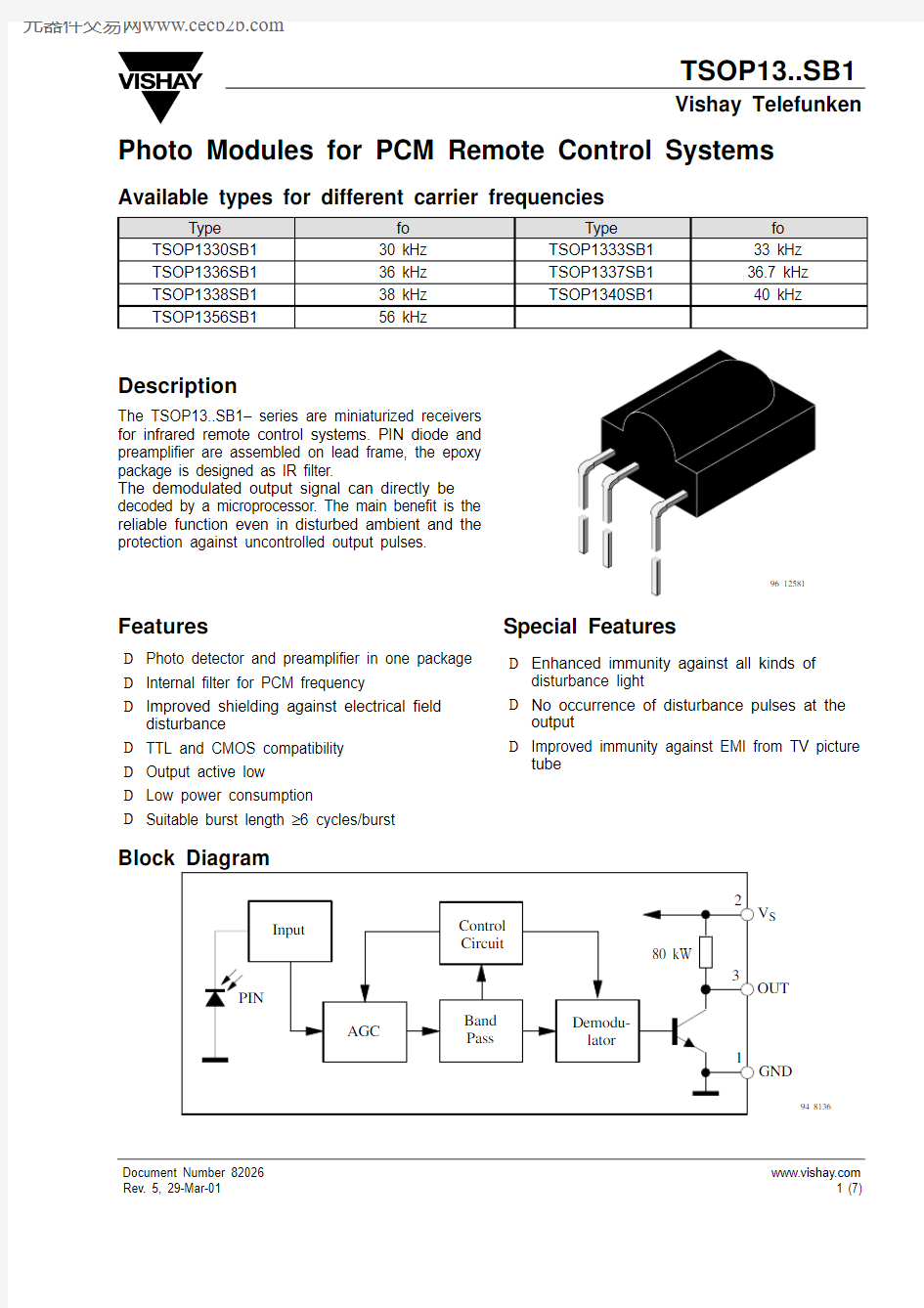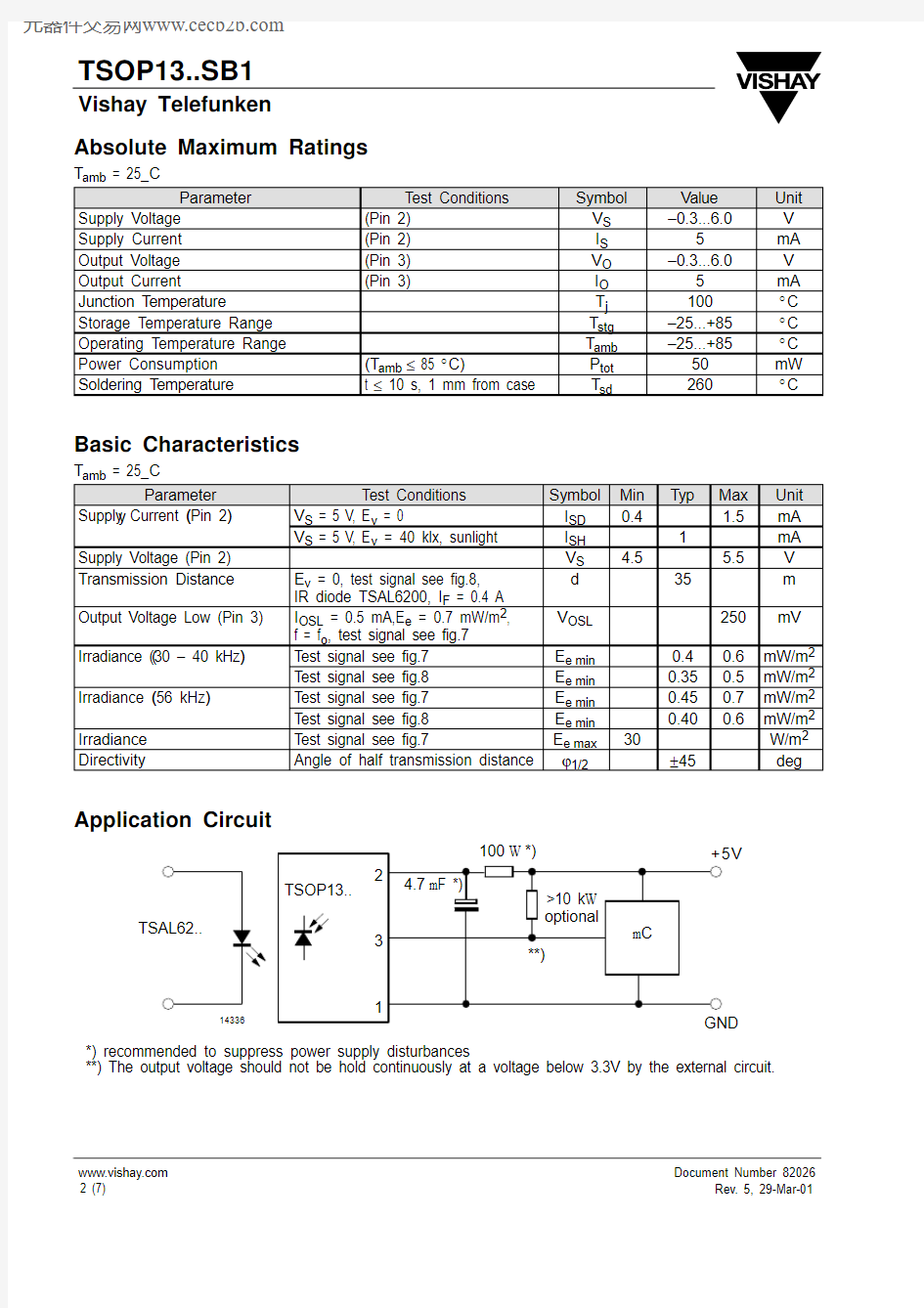TSOP1330SB1中文资料


Photo Modules for PCM Remote Control Systems Available types for different carrier frequencies
Type
TSOP1330SB1
TSOP1336SB1
TSOP1338SB1
TSOP1356SB1
Description
The TSOP13..SB1– series are miniaturized receivers
for infrared remote control systems. PIN diode and
preamplifier are assembled on lead frame, the epoxy
package is designed as IR filter.
The demodulated output signal can directly be
decoded by a microprocessor. The main benefit is the
reliable function even in disturbed ambient and the
protection against uncontrolled output pulses.
Unit
V
mA
V
mA
°C
°C
°C
mW
°C
Max Unit 1.5mA
mA 5.5V
https://www.wendangku.net/doc/e111006988.html,
Document Number 82026Suitable Data Format
The circuit of the TSOP13..SB1 is designed in that way that unexpected output pulses due to noise or disturbance signals are avoided. A bandpassfilter, an integrator stage and an automatic gain control are used to suppress such disturbances.
The distinguishing mark between data signal and disturbance signal are carrier frequency, burst length and duty cycle.
The data signal should fullfill the following condition:?Carrier frequency should be close to center frequency of the bandpass (e.g. 38kHz).
?Burst length should be 6 cycles/burst or longer.?After each burst which is between 6 cycles and 70cycles a gap time of at least 12 cycles is neccessary.?For each burst which is longer than 1.2ms a corresponding gap time is necessary at some time in the data stream. This gap time should be at least 6times longer than the burst.
?Up to 1000 short bursts per second can be received continuously.
Some examples for suitable data format are:
NEC Code, Toshiba Micom Format, Sharp Code, RC5Code, RECS–80 Code, R–2000 Code.
When a disturbance signal is applied to the TSOP13..SB1 it can still receive the data signal.However the sensitivity is reduced to that level that no unexpected pulses will occure.
Some examples for such disturbance signals which are suppressed by the TSOP13..SB1 are:
?DC light (e.g. from tungsten bulb or sunlight)?Continuous signal at 38kHz or at any other frequency
?Signals from fluorescent lamps with electronic ballast with high or low modulation (see Figure A or Figure B).
05101520
time [ms]
Figure A: IR Signal from Fluorescent Lamp with low Modulation
05101520
time [s]
Figure B: IR Signal from Fluorescent Lamp with high Modulation
2.0
/m ) Figure 4. Sensitivity vs. Electric Field Disturbances
1 kHz
E e
tpi *
V O V OH V OL
Optical Test Signal
( IR diode TSAL6200, I Output Signal
t d 1 )
12* t E e
Optical Test Signal
https://www.wendangku.net/doc/e111006988.html, Document Number 82026
95 11339p2
0.40.200.20.4
0.60.6
0.90°
30°
10°
20°
40°
50°60°70°80°
1.00.80.7
d rel – Relativ
e Transmission Distance Figure 13. Vertical Directivity ?y 95 11340p2
0.40.200.20.4
0.60.6
0.90°
30°
10°
20°
40°
50°60°70°80°
1.00.80.7
d rel – Relativ
e Transmission Distance
Figure 14. Horizontal Directivity ?x
Dimensions in mm
96 12225
https://www.wendangku.net/doc/e111006988.html,
Document Number 82026Ozone Depleting Substances Policy Statement
It is the policy of Vishay Semiconductor GmbH to
1.Meet all present and future national and international statutory requirements.
2.Regularly and continuously improve the performance of our products, processes, distribution and operating systems with respect to their impact on the health and safety of our employees and the public, as well as their impact on the environment.It is particular concern to control or eliminate releases of those substances into the atmosphere which are known as ozone depleting substances (ODSs).
The Montreal Protocol (1987) and its London Amendments (1990) intend to severely restrict the use of ODSs and forbid their use within the next ten years. Various national and international initiatives are pressing for an earlier ban on these substances.
Vishay Semiconductor GmbH has been able to use its policy of continuous improvements to eliminate the use of ODSs listed in the following documents.
1.Annex A, B and list of transitional substances of the Montreal Protocol and the London Amendments respectively
2.Class I and II ozone depleting substances in the Clean Air Act Amendments of 1990 by the Environmental Protection Agency (EPA) in the USA
3.Council Decision 88/540/EEC and 91/690/EEC Annex A, B and C (transitional substances) respectively.Vishay Semiconductor GmbH can certify that our semiconductors are not manufactured with ozone depleting substances and do not contain such substances.
We reserve the right to make changes to improve technical design and may do so without further notice.Parameters can vary in different applications. All operating parameters must be validated for each customer application by the customer. Should the buyer use Vishay-Telefunken products for any unintended or unauthorized application, the buyer shall indemnify Vishay-Telefunken against all claims, costs, damages, and expenses, arising out of, directly or indirectly, any claim of personal damage, injury or death associated with such unintended or unauthorized use.
Vishay Semiconductor GmbH, P .O.B. 3535, D-74025 Heilbronn, Germany Telephone: 49 (0)7131 67 2831, Fax number: 49 (0)7131 67 2423
